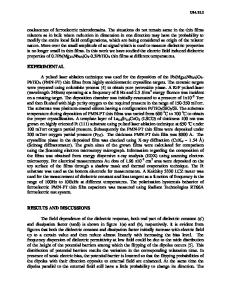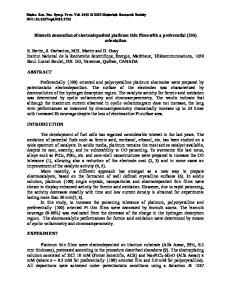Preferential orientation and dielectric/pyroelectric properties of sol-gel-derived Pb(Mg, Zn) 1/3 Nb 2/3 O 3 thin films
- PDF / 1,084,150 Bytes
- 11 Pages / 576 x 792 pts Page_size
- 27 Downloads / 295 Views
Thin films of Pb(Mg,Zn) 1/3^2/303 (PMZN) were fabricated by spin casting the partially hydrolyzed P b - M g - Z n - N b - 0 complex alkoxide sols on (111) Pt-coated MgO(lOO) planes. Analysis of the isothermal transformation data indicated that the growth of perovskite grains from the pyrochlore matrix is a diffusion-controlled process with an initial fast nucleation. The effect of water concentration in the sol on the preferential orientation of perovskite grains in the corresponding thin film was examined. A strong preferential orientation of (100) perovskite was obtained in the PMZN thin film derived from the sol having a molar ratio of H2O to total metal alkoxides (Rw) of 2. A small-angle x-ray scattering (SAXS) experiment in the Porod region indicated that weakly branched precursor systems led to highly (lOO)-oriented perovskite grains after thin-film formation. The pyroelectric coefficient and the corresponding figure-of-merit were controlled by suitably varying the degree of preferential orientation during the fabrication of thin films.
I. INTRODUCTION
p = (8Ps/dT)Eb +
Relaxor ferroelectrics with Pb(Bi/3B2/3)O3 perovskite structure undergo diffuse phase transition (referred to as DPT) and have a broad Curie maximum rather than the sharp and distinct Tc of normal ferroelectrics.1 Among relaxor ferroelectric materials, Pb(Mgi/3Nb2/3)O3 (PMN) is the most extensively studied. Its high peak value of relative dielectric permittivity of > 15,000 makes it one of the most attractive materials for multilayer ceramic capacitors (MLCC),2 electrostrictive actuators,3 and DRAM applications in thin-film forms.4 However, there have been relatively few reports on PMN-based thin films,4"7 especially on the control of preferential orientation of perovskite grains.5 Because of the formation of stable pyrochlore phase and microchemical inhomogeneity, the processing of PMNbased perovskite thin films with desired properties is difficult.4 In general, oriented ferroelectric thin films offer technical advantages for a wide range of electronic and optical applications. Since the net spontaneous polarization (Ps) and its temperature-dependence are expected to be zero for the randomly oriented perovskite grains, the corresponding pyroelectric coefficient (p) is also expected to be zero in the absence of applied dc bias
field (Ehf»:
"'Author to whom correspondence should be addressed. J. Mater. Res., Vol. 10, No. 10, Oct 1995 http://journals.cambridge.org
Downloaded: 25 Mar 2015
Eb(de/dT)Eb,
(1)
where e is the dielectric permittivity, and T is absolute temperature. Therefore, highly oriented perovskite grains are necessary for the applications to pyroelectric sensing devices that utilize conventional ferroelectric mode (i.e., pyroelectric sensor without applied dc bias). Furthermore, the problems associated with the depoling of a polycrystalline specimen caused by aging or local heating can be effectively removed by a preferential orientation. The present study focuses on the fabrication of preferentially oriented PMN-based thin
Data Loading...











